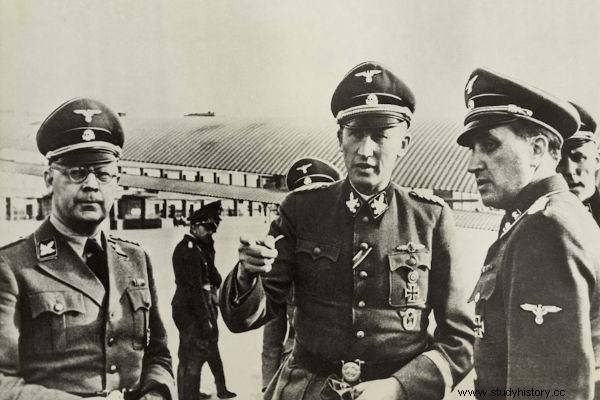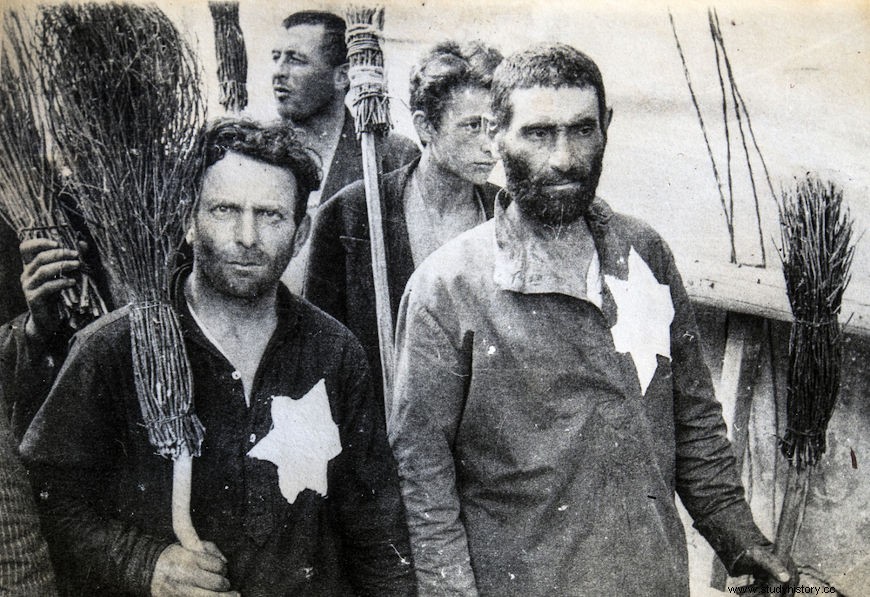The Gestapo was the secret police that existed in Nazi Germany, being created by the initiative of Hermann Göring and Rudolf Diels. It was the function of the secret police to investigate all opponents of the Nazi regime. The Gestapo was used to persecute socialists, communists, Jews and anti-fascist groups. Torture and execution were common practices used by police officers .
Read more :Crystal Night – the pogrom that drove thousands of Jews to concentration camps
Emergence of the Gestapo
The Gestapo was the German secret police and its role was to monitor society and persecute groups that posed a threat to Nazi ideology. The term “Gestapo” is a contraction of Geheim Staatspolizei , which means “secret state police”. This secret police was instrumental in the Nazis' control of German society.

The Gestapo grew out of the secret police structure Prussian that existed since the 19th century and was also responsible for monitoring society. After the German monarchy fell and a social democratic republic emerged, the Prussian secret police continued to exist, and their role was to repress groups such as communists and far-right groups.
The Nazi rise to power in Germany in the early 1930s saw the Prussian secret police being used against communists and socialists until it eventually became the Gestapo. . Transformations in the Prussian secret police began when Franz von Papen became Chancellor of Germany in 1932.
This chancellor named Hermann Göring as Minister of the Interior (the portfolio responsible for security in Germany), and, as Göring was a member of the Nazi Party, he quickly acted to get the Prussian police force to go after the Communists. He teamed up with the head of the Prussian secret police, Rudolf Diels, to achieve this goal.
Historians are not sure who came up with the idea of creating the Gestapo , but we know that Göring promoted himself as the one who proposed it. In January 1933, Adolf Hitler took over as German Chancellor, and a incident the following month changed German history and led to the emergence of the Gestapo.
The fire of the Reichstag (German Parliament) took place on February 27, 1933, and historians attribute its authorship to a Dutch communist named Marinus van der Lubbe . He acted independently, without the help of any of the big communist parties in Germany or the Netherlands.
At the time and in the years that followed, the possibility of the Nazis having carried out this fire to promote the closure of the regime in Germany was much questioned. However, this has never been proven. What we do know is that, regardless of authorship, the burning of Parliament was in fact used to force stricter measures to be taken by the Nazis.
The day after the fire, Hitler ends all civil liberties existing in Germany and established a mechanism that determined that a person could be detained by government agents if such an action was understood to be “protective detention”. The logic was to detain individuals who were “under threat”, with the state arresting them to ensure their protection.
It was a mechanism that served to justify the imprisonment of people without it being necessary to present a charge against any of them in court. This mechanism was widely used by the Gestapo during the 1930s, and served as a justification for the imprisonment of people who would be sent to concentration camps.
This law, which ended individual freedoms in Germany, became known as the Reichstag Fire Decree , issued on February 28, 1933. The creation of the Gestapo took place, through the Gestapo Law , on April 26, 1933 .
Learn more:Concentration camps in the USA – imprisoned Japanese immigrants in the early 20th century. XX
Secret Police Consolidation

After it was created, the Gestapo was still very active limited and limited to the territory of Prussia. The growth and consolidation of this secret police took place when Heinrich Himmler started to command it. However, the first head of the Gestapo was Hermann Göring .
When Himmler took over the Gestapo, starting in 1934, the institution underwent a series of transformations carried out in partnership with Reinhard Heydrich. Among these transformations was the subordination of the Gestapo to Schutzstaffel — the SS , elite troops of the Nazis. Furthermore, under the hands of Himmler and Heydrich, the Gestapo was federalized and began to operate throughout Germany.
All these transformations that the secret police underwent were the result of the alliance of Göring and Himmler against Ernst Röhm, leader of the Sturmabteilung — the SA, Nazi storm troopers. Between 1933 and 1934, there was a serious struggle behind the scenes of Nazism between SS and SA for greater power. This dispute between Himmler and Röhm also led to the purge of the SA and the assassination of Ernst Röhm in 1934.
After the SA threat was overcome and the process of federalizing the Gestapo began, Himmler brought secret police into action virtually all over Germany. Still, we cannot overestimate the ability of the Gestapo to act, and in 1939, for example, it had some 15,000 employees . Many cities in Germany did not have any secret police officers.
During the 1930s, Himmler integrated the Gestapo with other police forces in Germany, and for that, the Reich Central Security Office was formed , called in the original Reichsicherheitshauptamt , or RHSA, in the German acronym. This office contained the following police:
- Orpo (Ordungspolizei ):order police;
- Kripo (Kriminalpolizei ):police responsible for investigating serious crimes;
- SD (Sicherheitsdienst ):intelligence agency.
Read more: Nuremberg Laws – Anti-Semitic Laws That Realized Nazi Hatred of Jews
How did the Gestapo act?

An essential part of the Gestapo's functioning were the complaints . Anonymous reports were essential for the police to be able to investigate crimes such as “sexual corruption”, for example. From 1935, in Germany it was interracial marriage prohibited between Jews and Germans, as well as interracial sexual intercourse .
Those found to be breaking this law were accused of sexual corruption , and historians claim that the Gestapo's monitoring of crimes like this was only possible because of anonymous reports. Anyway, the Gestapo also had their body of spies and its work of monitoring society.
The Gestapo was divided into six departments , each one being responsible for a different focus of action. The six sections of the Gestapo were:
- Section A :responsible for monitoring Marxists, communists, reactionaries and liberals;
- Section B :responsible for monitoring Catholics, Protestants, Jews and Freemasons;
- Section C :processed preventive detention orders;
- Section D :responsible for monitoring the territories occupied by the Nazis;
- Section E :responsible for monitoring espionage actions in Germany;
- Section F :carried out the policing of foreigners and border services.
There was a very big difference between employees in elite positions and ordinary employees . The most important positions in the Gestapo were dedicated almost exclusively to men with higher education, especially those who had degrees in law. Ordinary officials were lower-middle-class and lower-class men and were rarely promoted in office.
All Gestapo employees had manuals on how to conduct an investigation, how to infiltrate, make arrests and conduct interrogations. Most cases went through the normal stages of any police case, including a courtroom. Still, the Gestapo made the use of torture in certain situations.
Section D of the Gestapo had direct involvement with the Holocaust, as its officials were part of the extermination groups that killed around a million Jews by firing squad in Eastern Europe, the Einsatzgruppen . After the war, a considerable part of the former Gestapo employees managed to avoid being prosecuted for their actions during the Nazi regime.
Login also :Munich Conference – the agreement that secured the invasion of Czechoslovakia
End of the Gestapo
With the German defeat in World War II, Germany went through a process of “denazification”, and with that, the Nazi institutions ceased to exist. The Gestapo was classified as a organization criminal, and ex-employees who didn't escape a trial got light sentences, being sentenced to up to three years of prison. Himmler and Göring were arrested, but both committed suicide.
Göring was tried and sentenced to death by hanging, but committed suicide before his execution. Heinrich Müller, the last head of the Gestapo, was killed shortly before the German defeat. He is believed to have died during a Soviet bombing of Berlin in 1945.
Image credits
[1] Massimo Todaro and Shutterstock
[2] Everett Historical and Shutterstock
[3] IgorGolovniov and Shutterstock
